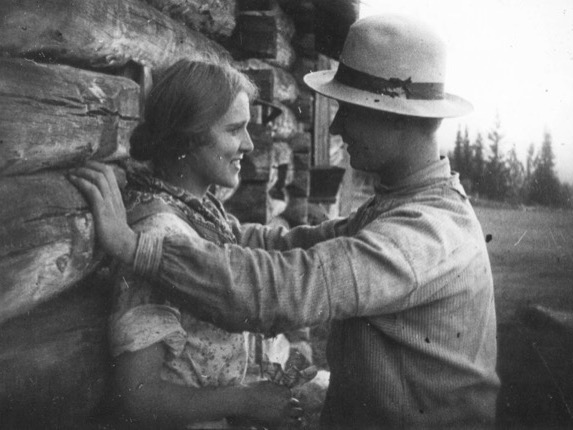GLOMDALSBRUDEN
[La fidanzata di Glomdal/The Bride of Glomdal]
Carl Th. Dreyer (NO 1926)
Just before Dreyer went to France to become famous in world film history with La Passion de Jeanne d’Arc he made The Bride of Glomdal for the Norwegian-Swedish company Victoria-Film in Norway in the summer of 1925. The film is based on a novel of the same title by Norwegian author Jacob Breda Bull (1853-1930), and is a classic example of the Norwegian Village film, in which contemporary love stories take place in sunny Norwegian villages. Since the actors only had the summer off from their respective theatre contracts, Dreyer for the first and last time in his career decided to be looser in the preparations for a film – the shooting was virtually improvised from day to day, without a script. A list of individual scenes was made, though, including some narrative elements from Bull’s novel Eline Vangen, since Dreyer felt that the novel Glomdalsbruden didn’t contain enough story elements.
Dreyer is loyal to Bull’s novels in terms of narrative elements and thematic content. Thematically both novels contain a central social criticism of parents arranging the marriage of their children, and in both plots the clergy steps in and restores moral justice. Dreyer adopts this view of the basic conflict in Bull’s novels – thus it is the only time where the clergy becomes the moral voice in a Dreyer film. Dreyer’s representation of the characters to some extent departs from Bull, especially in his depiction of Berit and Gjermund. In the film, Berit is more rebellious against her father’s decision to marry her to Gjermund. In the scene in which the marriage is being arranged, she declares: “They are in there negotiating as if I were a piece of cattle!” This line is not in Bull’s original novel. The depiction of Gjermund is perhaps the best example showing that Dreyer’s humanism is more inclusive than Bull’s. In Bull’s story, Gjermund is described in an unequivocally negative manner, while in Dreyer’s film he too is seen as a victim of the old men’s bargaining.
In many descriptions of The Bride of Glomdal it is assumed that the film is relatively complete, but at the premiere in Oslo the film’s length was 2525 metres, whereas the surviving material is only 1250 metres. The surviving version, though coherent and logical, differs considerably from what appears in the original Norwegian title list. Probably a re-editing took place around the time of the Danish premiere on 15 April 1926. By comparing some production stills from an illustrated version of the novel with the Norwegian title list, and the Norwegian and Danish printed film programmes, it becomes clear that much footage is missing, especially the sequences from Eline Vangen giving a more nuanced depiction of Thore and his family. The most important loss is a longer sequence, in which Berit stays with Thore’s family after falling from a horse. During her stay we witness several erotic flirtations and Thore’s desperate drinking binges, which lead to confrontations with his father. In addition, several scenes seem to have been longer, with more dialogue (the Norwegian title list contains 30% more intertitles than the Danish). A number of lyrical nature sequences were probably also cut. Dreyer himself stated, “I have realized that the poor peasant’s son in the film is depicted in rough surroundings, whereas the rich farmer’s daughter is surrounded by a gentler nature.” This use of nature as a social contrast (a motif that also appears in Synnöve Solbakken) is not very obvious in the existing film, possibly because of its shortening after the premiere.
It is impossible to get a complete picture of the film as it looked at the premiere in Oslo. However, the surviving version of The Bride of Glomdal does not change the overall impression, that the film is an interesting and charming parenthesis in Dreyer’s oeuvre. In which, true to his nature, he criticizes the oppression of women and promotes a classical conciliatory humanism.
The restoration of The Bride of Glomdal was conducted by the Danish Film Institute in 2009, supervised by Thomas Christensen. The digital transfer was done from a new preservation master struck from a negative held at the Norwegian National Library. New combined Danish/English intertitles were produced to replace the German flash-titles in the preservation materials. The DCP has been transferred at 17 frames per second, giving the restored version a running time of just under 75 minutes.
Morten Egholm

scen, mont/ed: Carl Th. Dreyer; dai romanzi di/based on two novels by Jacob Breda Bull: Glomdalsbruden (1908), Eline Vangen (1906).
photog: Einar Olsen.
scg/des: Jens Wang.
cast: Einar Sissener (Thore Braaten), Tove Tellback (Berit Glomgaarden), Harald Stormoen (Jakob Braaten, padre di Thore/Thore’s father), Stub Wiberg (Ola Glomgaarden, moglie di Berit/Berit’s father), Alfhild Stormoen (Kari, madre di Thore/Thore’s mother), Einar Tveito (Gjermund), Oscar Larsen (Berger Haugsett, Gjermund’s father), Julie Lampe (Old Guri), Rasmus Rasmussen (il vicario/the vicar), Sophie Reimers (la moglie del vicario/the vicar’s wife).
prod: Victoria-Film AS.
uscita/rel: 01.01.1926.
copia/copy: DCP (da/from 35mm, 1250 [1457?] m.; orig. l. 2520 m.), 75′ (trascritto a/transferred at 17 fps); did/titles: DAN, ENG.
fonte/source: Det Danske Filminstitut, København.


 Italiano
Italiano